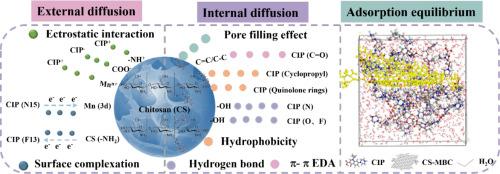壳聚糖/ mn改性生物炭对水中环丙沙星的去除效果:多位点活性中心协同吸附
IF 9.8
1区 工程技术
Q1 ENGINEERING, CHEMICAL
引用次数: 0
摘要
环丙沙星(CIP)对水资源的广泛污染需要有效的修复技术。生物炭是一种很有前途的吸附剂,但其吸附能力有限,阻碍了其实际应用。为了弥补这一空白,本研究提出了一种新型壳聚糖-锰共改性生物炭(CS-MBC),通过耦合浸渍-热解方法进行工程设计。这一策略改进显著提高了CS-MBC的吸附性能,其最大CIP容量为167.08 mg·g-1,大大优于原始BC。这项工作的新颖之处在于壳聚糖生物聚合物和锰氧化物的协同整合,为CIP结合创造了多个活性位点。关键是,CS-MBC在复杂环境中表现出了出色的稳健性和实用性,在不同离子强度、腐植酸存在和实际水基质中保持高效率。结合先进的表征和理论计算(DFT和MD)阐明了增强的吸附机制:(1)Mn与CIP的哌嗪基团之间的配位,(2)优化的π-π电子供体-受体相互作用,(3)表面氨基/羟基促进的氢键和静电相互作用。这项工作不仅提供了一种高效、可持续的抗生素去除吸附剂,而且提供了深刻的机制见解,可以指导未来设计用于环境修复的高级功能化材料。本文章由计算机程序翻译,如有差异,请以英文原文为准。

Enhanced ciprofloxacin removal from water by chitosan/Mn-modified biochar: Synergistic adsorption at multi-site active centers
The widespread contamination of water resources by ciprofloxacin (CIP) necessitates efficient remediation technologies. While biochar (BC) is a promising adsorbent, its practical application is hindered by limited adsorption capacity. To bridge this gap, this study presents a novel chitosan-manganese co-modified biochar (CS-MBC) engineered through a coupled impregnation-pyrolysis method. This strategic modification significantly enhanced the adsorption performance, with CS-MBC achieving a maximum CIP capacity of 167.08 mg·g-1, vastly outperforming pristine BC. The novelty of this work lies in the synergistic integration of chitosan biopolymer and manganese oxides, which created multiple active sites for CIP binding. Crucially, CS-MBC demonstrated exceptional robustness and practicality in complex environments, maintaining high efficiency across varying ionic strengths, in the presence of humic acid, and in real water matrices. A combination of advanced characterization and theoretical calculations (DFT and MD) elucidated the enhanced adsorption mechanisms: (1) coordination between Mn species and the piperazine group of CIP, (2) optimized π-π electron donor-acceptor interactions, and (3) hydrogen bonding and electrostatic interactions facilitated by surface amino/hydroxyl groups. This work not only provides a highly effective and sustainable adsorbent for antibiotic removal but also offers deep mechanistic insights that can guide the future design of advanced functionalized materials for environmental remediation.
求助全文
通过发布文献求助,成功后即可免费获取论文全文。
去求助
来源期刊

Desalination
工程技术-工程:化工
CiteScore
14.60
自引率
20.20%
发文量
619
审稿时长
41 days
期刊介绍:
Desalination is a scholarly journal that focuses on the field of desalination materials, processes, and associated technologies. It encompasses a wide range of disciplines and aims to publish exceptional papers in this area.
The journal invites submissions that explicitly revolve around water desalting and its applications to various sources such as seawater, groundwater, and wastewater. It particularly encourages research on diverse desalination methods including thermal, membrane, sorption, and hybrid processes.
By providing a platform for innovative studies, Desalination aims to advance the understanding and development of desalination technologies, promoting sustainable solutions for water scarcity challenges.
 求助内容:
求助内容: 应助结果提醒方式:
应助结果提醒方式:


